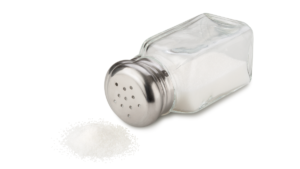
You may have heard of “macros” if you’ve looked into any sort of dieting. Counting macros has become very popular these last few years – and for good reason. But it can also be confusing and overwhelming if you don’t understand what macros really are.
In this blog, I will detail (in an easy way) exactly what macros are and why they are essential. Let’s make it make sense!
What are macronutrients?
There are three macronutrients and any food you can think of (any food in the world!) will be in one of these three categories. The three macros are protein, carbohydrates, and fats. You have more than likely heard of these. Each macro has an essential role for the body, and you’ll be happy to find out, you need all of them – even carbs!
What makes a food a certain macronutrient is what it breaks down to in the body. Protein breaks down into tiny chains of amino acids. Carbohydrates break down into glucose molecules, and fats break down into fatty acid molecules. Each of these tiny molecules has different functions in the body.
Protein and Its Role in the Body
Protein is mainly known for growing muscle and aiding recovery after exercise. But it has so many other important roles in the body, that you should be getting a good amount every day even if you don’t exercise.
 Protein transports nutrients throughout the body, regulates fluid balance, and carries enzymes that are essential for bodily functions such as digestion and blood clotting. Important, right?! A huge role protein has is acting as a messenger for hormone function. Protein amino acids tell the body when to uptake sugar into the cell (insulin), and when to build more tissue, including bone (human growth hormone).
Protein transports nutrients throughout the body, regulates fluid balance, and carries enzymes that are essential for bodily functions such as digestion and blood clotting. Important, right?! A huge role protein has is acting as a messenger for hormone function. Protein amino acids tell the body when to uptake sugar into the cell (insulin), and when to build more tissue, including bone (human growth hormone).
The sources listed below are mainly animal protein, and that is because that is where you will find all the essential amino acids that you have to get through your diet. If you’re a vegan or vegetarian, you can still get the protein you need through plants, you just have to mix and match in order to get all the amino acids needed.
Protein Sources:
- Beef
- Chicken
- Turkey
- Pork
- Tofu
- Seafood and Shellfish
- Eggs
- Egg Whites
Carbohydrates and Their Role as Macronutrient
A carb’s main purpose in the body is to create energy. Your body takes in carbs, breaks them down into glucose molecules, then sends those glucose molecules through the Krebs cycle to create ATP (which is energy). Ever feel sluggish in the afternoon? Try eating some fruit or whole wheat toast for an energy boost instead of drinking caffeine. You’ll be surprised at the energy it can give you.
The body can take fat or protein and turn it into energy, but it’s hard for the body to do. Carbs are the preferred source of fuel. In addition to creating energy, carbs also help spare protein so it can perform how it needs to. Fiber – a very healthy part of carbohydrates – is important for digestive health, controlling cholesterol levels, and keeping you full.
 Carbohydrates often get a bad rap for making people gain weight. But that is only true if they are overconsumed. If you are an athlete or have a very active job such as a nurse or construction worker, carbs will fuel the energy you need to perform well. Focus on high fiber, unprocessed carbs for the best results.
Carbohydrates often get a bad rap for making people gain weight. But that is only true if they are overconsumed. If you are an athlete or have a very active job such as a nurse or construction worker, carbs will fuel the energy you need to perform well. Focus on high fiber, unprocessed carbs for the best results.
Carbohydrate Sources:
- Bread
- Pasta
- Rice
- Oats
- Cereal
- Popcorn
- Fruit
- Vegetables
- Potatoes and Sweet Potatoes
- Juice
- Sugar
- Most drinks like tea and soda, unless it’s diet
Fat and Its Role as Macronutrient
Just like carbs, fat sometimes gets a bad rap for causing weight gain. Fat does not make you fat unless you overeat it. Fat is very calorie dense, but it’s not a bad thing as long as you’re aware. Fat is essential for brain health, cell protection, insulating organs, and storing backup energy. Fats also aid protein in hormone health. It’s what makes food taste good. Deep fry anything and it’s automatically going to be more scrumptious. That’s because fat is satiating and pleasing to the tongue. It’s also why it’s so easy to overeat. Anything packaged, processed, or fried is going to be higher in fat than its unprocessed counterpart. Consider using whole food fat sources rather than packaged or deep-fried food items to reap the health benefits fat can offer.
Fat Sources:
- Oil
- Butter
- Nuts
- Nut Butter
- Seeds
- Avocado

One of the biggest misconceptions is that peanut butter is a protein source. Just because the label says it has protein in it, does not mean it’s a good protein source. It breaks down in the body as fat- it is a fat source. This is one reason it’s imperative to know what macronutrients are and what foods to eat to get them. Don’t let front labels do the work for you- turn it to the back and look at what the food item is actually made of. All nutrition labels have a protein, carb, and fat count on the back.
There are some foods that can fit into several of the categories such as dairy. Milk, yogurt, and cheese can have a good amount of all three – protein, carbs, and fat. All food offers different health benefits through the vitamins and minerals it has, so a varied diet should be considered.
Any diet that completely eliminates one or more macros – like all carbs or all fats – is not a healthy diet. It may allow you to drop some water weight quickly, but it will not aid in overall health or long-term fat loss.
Now that you know what macronutrients are, it’s time to learn exactly how much you need in order to fuel your body well. For that guidance on nutrition and what you need to do to manage your health, email Jalpa to set up a consultation!
Jalpa is a registered dietitian and nutritionist with a Master’s degree in Health & Nutrition from Brooklyn College, CUNY in New York. She also holds a Certificate of Training in Adult Weight Management through the Academy of Nutrition & Dietetics, CDR.
Related Articles:




 Watching sodium intake is essential nutrition hack for men’s heart health, as excessive sodium consumption can contribute to high blood pressure and increase the risk of heart disease. Here are some practical tips to help Dad monitor and reduce his sodium intake:
Watching sodium intake is essential nutrition hack for men’s heart health, as excessive sodium consumption can contribute to high blood pressure and increase the risk of heart disease. Here are some practical tips to help Dad monitor and reduce his sodium intake:

 While prenatal diet should be more individualized and tailored for individual pregnancy, here are some must have’s to nourish our moms-to-be:
While prenatal diet should be more individualized and tailored for individual pregnancy, here are some must have’s to nourish our moms-to-be:




 While the supplement industry is regulated to some extent, it’s essential to approach product claims with a critical eye. Not all supplements are created equal, and some may contain contaminants, inaccurate labeling, or ineffective ingredients. To ensure reliability:
While the supplement industry is regulated to some extent, it’s essential to approach product claims with a critical eye. Not all supplements are created equal, and some may contain contaminants, inaccurate labeling, or ineffective ingredients. To ensure reliability:
 Tip 1. Shift your mindset from Diet to Lifestyle
Tip 1. Shift your mindset from Diet to Lifestyle








 3. Controlling Diabetes through Diet
3. Controlling Diabetes through Diet 3. Weight Management and Exercise
3. Weight Management and Exercise

 Deciphering Food Labels: What to Look For
Deciphering Food Labels: What to Look For





 So, make a list of a few protein sources you like, a few carb sources, and a few fat sources. Use these to piece meals together. You can even bulk prep, and save time as well. For example, prepare a large batch of shredded chicken and ground turkey. Don’t season it until you’re ready to eat – that way, you can change the seasonings or sauce for each meal and not have to eat the exact same thing every day. Next, prep a large batch of rice or sweet potatoes, and have some tortillas on hand. For your fat sources, you could use olive oil and avocados. Now that all of these macronutrients are prepped, you can throw dinner or lunch together in a matter of minutes. And you can mix and match so that you’re not getting bored with what you’re eating. One day can be ground turkey tacos with avocado, one day can be shredded chicken tacos, and one day can be ground turkey rice bowls with any veggies that you like. If you stick to bulk prepping the three main macronutrients, you can eat very healthily on a budget.
So, make a list of a few protein sources you like, a few carb sources, and a few fat sources. Use these to piece meals together. You can even bulk prep, and save time as well. For example, prepare a large batch of shredded chicken and ground turkey. Don’t season it until you’re ready to eat – that way, you can change the seasonings or sauce for each meal and not have to eat the exact same thing every day. Next, prep a large batch of rice or sweet potatoes, and have some tortillas on hand. For your fat sources, you could use olive oil and avocados. Now that all of these macronutrients are prepped, you can throw dinner or lunch together in a matter of minutes. And you can mix and match so that you’re not getting bored with what you’re eating. One day can be ground turkey tacos with avocado, one day can be shredded chicken tacos, and one day can be ground turkey rice bowls with any veggies that you like. If you stick to bulk prepping the three main macronutrients, you can eat very healthily on a budget.  To get the best bang for your buck, you need to
To get the best bang for your buck, you need to 